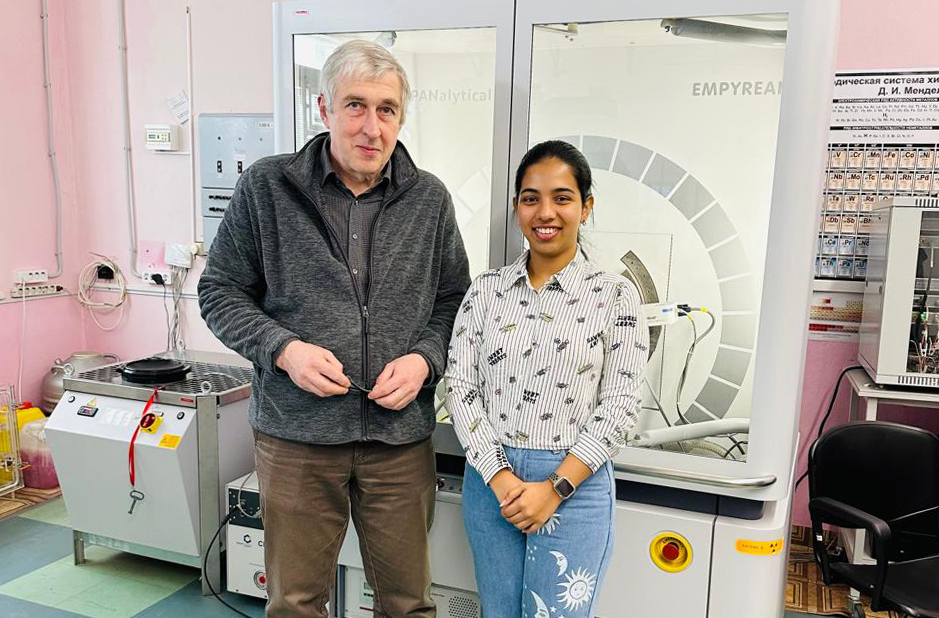Collaborative articles by JINR and participants of INTEREST and START Student Programmes published
News, 09 January 2025
In 2024, two publications were issued in Minerals and Nonlinear Phenomena in Complex Systems, co-authored by JINR researchers and participants of the international INTEREST and START Student Programmes.
 Dmitry Nikolayev and Sancia Morris
Dmitry Nikolayev and Sancia Morris
The article entitled “Annihilation in the gluon dominance model” was published in Nonlinear Phenomenon in Complex Systems. The authors are VBLHEP employees Elena Kokoulina, Vladimir Nikitin, and Vsevolod Popov, along with participants of the INTEREST Programme: Tatiana Gorelkina from Peter the Great St. Petersburg Polytechnic University, Yeiris Caballero Duran from the Higher Institute of Technologies and Applied Sciences (Cuba), Krittika Sarkar from the University of Calcutta (India), Elizaveta Shakhvorostova from Moscow State University, and Yara Shousha from Alexandria University (Egypt).
The article discusses experiments at modern accelerators aimed at studying hadron structure and searching for new physical phenomena. Although the results are in good agreement with the modern theory of strong interactions, quantum chromodynamics (QCD), it cannot be used to describe hadronisation. The authors apply statistical methods based on Markov branching processes and supplement it with a phenomenological description of the process of quarks and gluons transforming into observable hadrons. The behaviour of the multiplicity distribution of secondary hadrons for the main types of annihilation is described. In particular, the researchers propose an original mechanism of proton-antiproton annihilation at the level of valence quarks and antiquarks that is in good agreement with the data and provides significant clarification. The hadronisation scheme remains universal in all processes of multiple production, but its mechanism changes from fragmentation in electron-positron annihilation to recombination in hadron collisions.
Elena Kokoulina shared her experience of working with the students:
“Before coming to JINR, I was a teacher, so I have a natural desire to share knowledge with the youth. For many years, I have been inviting students to my projects. The first students were from Belarus, then from the Czech Republic, Slovakia, and Romania. During the internships, I met young people from Egypt, South Africa, Italy, and Uzbekistan. I helped students from the Belarusian State University of Informatics and Radioelectronics (BSUIR) find scientific supervisors.
Due to the pandemic, we had to make changes to this activity. UC proposed the remote INTEREST Programme. Ever since I have worked with students from Brazil, Cuba, Egypt, India, Romania, Serbia, Vietnam, and, of course, Russia and Belarus. INTEREST disciplines students by setting clear deadlines for their projects and offering regular online meetings, thus ensuring close contact with the supervisor. Most of the students are passionate about scientific work and interested in continuing cooperation. In addition, engaging with young people inspires me to set new goals and work on the postpone ones. When explaining physics problems to students, I structure my knowledge and look for the right words. This encourages me to improve professionally, including enhancing my English skills.
The article on annihilation would hardly have been written if it wasn’t for the active dialogue with my students. They just left me no other choice. Admittedly, there were things I had to learn from them, such as designing schedules. Another wave of the internship has ended, and although we haven’t achieved all the goals set, I hope that the young researchers have gained a lot of experience and knowledge to share in their universities. I wish for the JINR employees to be open for work with students. It will give you valuable experience, satisfaction from what you have taught, and a great incentive in your scientific activities”.
The second article, titled “Local crystallographic texture of alpha qu artz in silicified Wood (Late Triassic, Madagascar)”, was published in Minerals. It was written by FLNP employees Alexey Pakhnevich, Tatiana Lychagina, and Dmitry Nikolayev in cooperation with Sancia Morris, a student at the Department of Chemical Engineering at the Institute of Chemical Technology of Mumbai (India) who participated in START.
The article discusses studies of silicified fossil wood with high quartz content from the Upper Triassic deposits in Madagascar. The crystallographic texture of a fossil tree was studied on the basis of pole figures measured by X-ray diffraction. The results showed that the crystal texture is sharper in the heartwood part compared to sapwood. An X-ray tomographic examination was performed as well, revealing a high concentration of iron-containing compounds in sapwood. This is the first study to analyse the crystallographic texture to understand the processes of replacement of organic matter by minerals.
Upon commenting on the contribution of Sancia Morris, Tatiana Lychagina noted that she proved to be a dedicated and responsible student. During her internship, she learned the basics of measurement techniques that were new to her. She directly participated in obtaining the results and working on the article.
The Joint Institute for Nuclear Research is interested in developing the international INTEREST and START Student Programmes that help attract talented young people from all over the world to participate in cutting-edge scientific research.